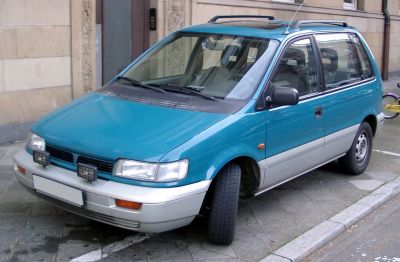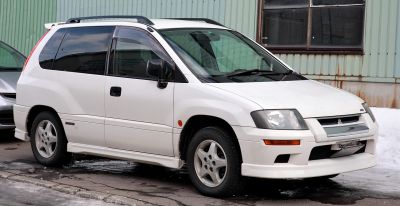 1999 Mitsubishi Space Runner (N50) Dimensions, Size & Specs
1999 Mitsubishi Space Runner (N50) Dimensions, Size & SpecsMeasurements of the 1999 Mitsubishi Space Runner, engineered for optimal performance and comfort
| Dimensions | |
|---|---|
| Length: | 4290 mm168.9 in14.1 ft |
| Width: | 1695 mm66.7 in5.6 ft |
| Height: | 1650 mm65.0 in5.4 ft |
| Trunk Capacity: | 430 liter15.2 cu ft |
| Trunk Capacity (Max): | 1800 liter63.6 cu ft |
| Weight Specifications | |
| Curb Weight: | 1300-1400 kg2866-3086 lbs |
| Maximal permitted Weight: | 1880-1920 kg4145-4233 lbs |
| Tire Specifications | |
| Tire Size: |
|
The Mitsubishi Space Runner N50, produced between 1999 and 2002, is a versatile minivan designed to provide practical space and comfortable transport for families and small groups. Measuring 4290 mm (168.9 inches) in length, 1695 mm (66.7 inches) in width, and standing 1650 mm (64.9 inches) tall, this vehicle offers a balanced size ideal for urban driving and parking while maximizing interior volume. Weighing between 1300 and 1400 kg (2866 to 3086 lbs) when empty, the Space Runner supports a maximum gross weight ranging from 1880 to 1920 kg (4144 to 4233 lbs), indicating its capability to handle passengers and cargo efficiently.
One of the key features of the Space Runner N50 is its impressive luggage capacity. With all seats in use, the minivan offers 430 liters (15.2 cubic feet) of cargo space, allowing users to carry daily belongings or small loads comfortably. When the rear seats are folded down, the luggage capacity expands substantially to 1800 liters (63.6 cubic feet), providing ample room for larger cargo such as suitcases or sports equipment. The vehicle rides on 205/65 R15 tires, which contribute to a smooth and stable driving experience.
Overall, the Mitsubishi Space Runner N50 combines a practical footprint with efficient use of interior space, making it suitable for those seeking a dependable and spacious minivan from the late 1990s to early 2000s. Its blend of moderate dimensions, good cargo flexibility, and reliable weight handling makes it a notable contender in the compact minivan segment of its era.
Discover the standout features that make the 1999 Mitsubishi Space Runner a leader in its class
Have a question? Please check our knowledgebase first.
The Mitsubishi Space Runner (N50) minivan measures 4290 millimeters (168.9 inches) in length, 1695 millimeters (66.7 inches) in width, and 1650 millimeters (64.96 inches) in height. These dimensions provide a balance between interior space for passengers and cargo while maintaining a compact exterior that suits urban and suburban driving environments. The relatively modest width helps with maneuverability in tighter spaces compared to larger minivans, and the height ensures a comfortable seating position for occupants.
The Mitsubishi Space Runner's curb weight ranges between 1300 to 1400 kilograms (2866 to 3086 pounds), reflecting the vehicle's weight without occupants or cargo but with all standard equipment and necessary operating consumables like fuel and fluids. Its maximum weight capacity, or Gross Vehicle Weight Rating (GVWR), falls between 1880 and 1920 kilograms (4145 to 4233 pounds). This rating indicates the maximum legally allowed total weight of the vehicle including passengers, cargo, and fuel, which is crucial for safe loading and optimal vehicle performance.
With the rear seats in their upright position, the Mitsubishi Space Runner offers 430 liters (approximately 15.2 cubic feet) of luggage capacity, enough for several large suitcases or a good amount of groceries and personal items. When the rear seats are folded down, the available cargo space dramatically increases to 1800 liters (about 63.6 cubic feet), allowing for the transport of larger items, furniture pieces, or an extensive amount of luggage. This flexibility makes the Space Runner suitable for families, outdoor activities, and small business needs.
The Mitsubishi Space Runner is equipped with tires sized 205/65 R15. This means the tires have a width of 205 millimeters (8.07 inches), an aspect ratio of 65% (sidewall height compared to width), and fit on 15-inch diameter wheels. This tire specification provides a comfortable ride with good traction and stability, supporting the minivan’s weight and enhancing handling characteristics. The tire size also plays a role in fuel efficiency and road noise, balancing practicality for daily driving and long-distance trips.
Yes, the Mitsubishi Space Runner (N50) comfortably fits into a standard home garage. Most residential garages are built to accommodate vehicles up to around 5,000 millimeters (197 inches) in length and approximately 2,500 millimeters (98 inches) in width, including space for opening doors and some room for walking around. Given the Space Runner’s length of 4290 millimeters (168.9 inches), width of 1695 millimeters (66.7 inches), and height of 1650 millimeters (64.96 inches), it fits well within these dimensions. Owners should ensure garage door height and width comply with these measurements for smooth access.
The Mitsubishi Space Runner (N50) introduced in 1999 represents a refined evolution over its predecessor, generally featuring an increase in overall length and height to enhance interior space and comfort. Although exact predecessor dimensions vary based on model specifics, the N50’s substantial 4290 mm (168.9 inches) length and 1650 mm (64.96 inches) height provide improved passenger headroom and cargo capacity. These dimensional enhancements contributed to better ergonomics and versatility, making it more competitive in the minivan segment compared to earlier versions that were slightly more compact.
In comparison to other minivans produced in the late 1990s and early 2000s, the Mitsubishi Space Runner (N50) is moderately sized. For example, it is typically smaller than larger full-size minivans like the Toyota Previa or Honda Odyssey but larger than compact MPVs. Its length of 4290 mm (168.9 inches) and width of 1695 mm (66.7 inches) position it well for buyers seeking a minivan that is easier to park and maneuver without sacrificing too much interior room. This range makes it competitive against similar segment vehicles, offering a good balance of size and practicality.
The Mitsubishi Space Runner (N50) is designed as a minivan with seating typically for 7 passengers, utilizing multiple rows of seats to maximize occupant capacity. The vehicle’s cabin emphasizes comfort with adequate headroom and legroom due to its height of 1650 mm (64.96 inches). The interior layout facilitates easy entry and exit, especially for rear passengers, and the flexible rear seats provide various configurations for passenger comfort or expanded cargo space. This flexibility, combined with decent luggage capacity, makes it a practical choice for families and group transport.
With a curb weight ranging from 1300 to 1400 kilograms (2866 to 3086 pounds), the Mitsubishi Space Runner (N50) benefits from a relatively lightweight platform for a minivan, which positively influences fuel efficiency and handling. A lighter vehicle requires less energy to move, allowing for better mileage and quicker acceleration than heavier competitors. However, payload capacity supporting weights up to 1880 to 1920 kilograms (4145 to 4233 pounds) ensures the vehicle can handle passengers and cargo without excessive strain, balancing performance with utility. This design supports both urban driving and longer trips with stable and predictable dynamics.
The Mitsubishi Space Runner (N50) typically came with modest engine options aimed at providing efficient, reliable transportation for families and commercial use. While exact engine sizes may vary regionally, common configurations included 4-cylinder gasoline engines that balance power output with fuel economy. The front-wheel-drive layout is typical for this class, contributing to more predictable handling and more effective use of interior space compared to rear-wheel-drive setups. This arrangement allows for a lower floor and easier passenger access while keeping the vehicle’s aerodynamic profile and weight distribution optimized for everyday usability.
Discover similar sized cars.

| Production: | 1991-1999 |
|---|---|
| Model Year: | 1991 |
| Length: | 4270-4290 mm168.1-168.9 in |
| Width: | 1695 mm66.7 in |
| Height: | 1640-1680 mm64.6-66.1 in |

| Production: | 1997-2002 |
|---|---|
| Model Year: | 1997 |
| Length: | 4280-4300 mm168.5-169.3 in |
| Width: | 1695 mm66.7 in |
| Height: | 1650 mm65.0 in |
